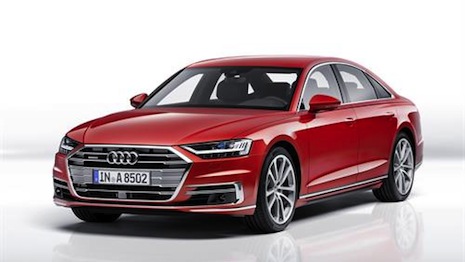During Ipsos' webinar “Affluents in the Fast Lane," it was revealed that Japanese automaker Lexus is by far the top brand that comes to the mind of affluents in terms of luxury vehicles.
When Ipsos asked affluent survey participants who comes to mind when thinking about a luxury car brand, Lexus was most popular amongst all generations. Findings also showed that when it comes to free time from autonomous driving, men were more likely to take advantage by interacting with entertainment compared to women, who are likely to continue pay attention to the road.
“Lexus is number one across the board regardless of generation. Mercedes is right up there but we see a big difference with BMW, hugely considered luxury by boomers but less so for millennials and seniors,” said Tony Incalcatera, senior vice president, U.S. at Ipsos Connect, Austin, TX. “Further analysis found that the generation who had more BMWs than any other is millennials.
“What we’re seeing here is that once you obtain the luxury brand, it is not perceived as luxury but more so the unobtainable still remains a luxury brand,” he said.
Unobtainable equals luxury
The research firm also found a strong correlation to brands who affluents perceived as luxury and whether or not they owned these vehicles.
Very few affluent millennials responded to Ipsos’ query in regards to what brands are luxury by naming BMW. However, the brand of vehicles millennials own the most is BMW.
 BMW 330e. Image credit: BMW
BMW 330e. Image credit: BMW
This shows that when it comes to perceiving which brands are luxury, the unobtainable is considered more high-end. Consumers want what they do not have.
Ipsos also found that while affluents have the money to purchase luxury vehicles, they also own mass-market brands. The majority of affluent households have a range of vehicles including luxury and mass market, with 90 percent owning a mass-market car.
There is a variety of innovations that are likely to be future disruptors on the road in the auto industry. For instance, one feature will have the vehicle find itself a parking spot or drive around autonomously until the driver is ready to leave.
While a number of affluent consumers are interested in these innovations, the amount decreases dramatically when asked if they are willing to pay for these features.
 Audi A8 will feature significant autonomous features. Image credit: Audi
Audi A8 will feature significant autonomous features. Image credit: Audi
For instance, when asked if they are willing to pay 3 percent of a vehicle’s purchase price, the number of interested parties drops in half.
Additional insight
German automakers BMW, Audi and Mercedes-Benz continue to dominate the luxury auto industry by making up approximately 80 percent of the market share, according to Smart Research Insights.
While the mass automobile sector has seen a tumultuous last few years, the leading brands of the luxury auto industry have remained virtually unaffected. Crossovers and SUVs are making the biggest impact in the luxury market (see more).
A combination of more affordable models and an increased focus on sport utility vehicles has helped luxury brands grow their market share in the broader automotive sector this year, according to a new report from Edmunds.
Changes such as new products and brands entering the luxury field for the first time are helping the segment attract new consumers. While luxury car sales have fallen since the record highs of last year, the category has seen its sales volume grow in 2017 (see more).
“Affluents are information hungry,” Ipsos Connect's Mr. Incalcatera said. “We see this across categories.
“We see this in terms of the media they are exposed to," he said. "They are often high consumers of publications, Web sites, etc., more so than the general public.
“What we see here is that there’s also a tactical approach to automobile purchases. This relies on going to see a car, which is not surprising giving these high price points.”
{"ct":"dBdDGGFKubUDHN4CP2W8PpJI4YdxB8ffUM3uwCO6nxvT5KL9iRFjBZZlL7rGP72qbsXgyja6\/ZoUkXnIy9+Cq1qc+\/NF5\/fdwblXvUtLUHT2LSeDnu8uQ\/WdAFP66mbYSDyFuvRRBFTfu4R5AeWNAJgW7R28BVp3fI7pLuXFrb0Y7Lza2dGXZle1zMOoeLpmlufTjUsHqj1R+cR2ejxpy8SYLp9WU9u3\/hSqku1pYfvpEjnu6fnTaAub\/uNR0aH3tEu0cXmn1SVZ4Pk+TR8IyGdE1S5csd1OMxhCxmEXCgkQ4zFVedYNAejLP\/DMJvAwxTIyl\/6frRbogC3jTjlCIxkonisD5NRhlNnlgtVDpkV6xhtWz284w1ySLS2EQt2CzFsDvgCo+kPpjjJxuK\/XtSPUUVyXN54Qa+HSAORbfXrF1aN4nqdbtlVXPJN4uiZatqhwlZlItuvXzYq38s0998YePnUfWMOHskJYMrWWXGBSEuu3w3OZpE7L8xCtDTfwERdxcFfDCKa7tNEP96hVhxUWtENGKlwM1\/LGtIOHtdLUrIaxK\/X+UohlGd4veTl7kFIC0VXCLxc7IO8o+9TZ2zznrcVjN9NEnLOR7Exmk\/P2n+FmN5R2tsqA3Mgew0QFqrsWUk7KvCu679EqV1K5jP\/V0GzJKKNJCquaP0BnFS+Q0wD0L91U1EpIvA0IMAT60j\/7Sz8oCK6Y2Ba7cCYbdFrjiKGxj+XPvXokm9mk+RiKelfjH+ShYqIKYgTG+XjqNWmI0vuN8\/nAfA4dF83PYEhzcUxbH45irQ3LNdAZ9XZa1dcaqhuktOpbIfzBfRVfemT5F56HUW5Is+DTzHpy9wBspxNx7WKdHFyR+HcRq8J1l5VPlc6\/cSMGKhB4+zOLBsRDRF2xgSd1EwEh4zUcLDcS7aeILnDRN4Gf1LJtlhHFwtewJFFAMJWagSl9G7kxYC0kfl08c2\/MuewOowKSlleWAqCoFO5hBanfT5QNiN1UjR4R3EiMRs2lHKFYXnEuoxkuNekcV2QJU4FH20bKdYtRALJ6nhj7ba8ajG8yt1eiYz\/IjeTgacx+Urj+TjjJq29A9gP9vsAhE8\/fyKFJmfkCjRZmF8iLCgbRDXGsVtny3\/Ci8ElfAi2oEzC9vq7QFNrtZM3erdzlA79R+FLXR5pxIdlQMvs6abuW0xeU6d+VE2GWeoEP8Gd6awE3ugxILJwlvubZK+ZBftMDT9QzOAWXhdUlpf2WDY5km7CJB8xIFU4O68MxpsFpgHhetbStm7jedWuSk9mi0enFZx5lFccempTsYz39mlJtbz+m+pdLP2Vt5kHLCJOaw5pl39srGOO8MOpAvDOILyWreOAJU7iWhNNj2\/z\/ffW5zH8Sl+sGTWKGSltcZ2Vb1mdREYID2l2yKZ1cE+4BUdcZq\/889\/u6ilnFgOUmVkO3eLbzrkkpeAC5z084JAGZ0tpr9nRhPqZOS9vsdxhj4NVt2i5rEKcLQAUYQDfpSEhIIxk\/22NCYFPe7Eql5esPIwvd2+IguWJ1Q3K0KZIvP8c7d27bbY4OAuTaZS2lRLLiMpzjU5j6PsoaT2G\/cQ7KzrJSx4Wksayj+QywlASi8rAVdLFpZIKAFs4LcViaSRIsunLrfAALGyiPNjIOP8phxSoR4HtOEsMP4bwPmpPx05LjYV4DdHPMLIJeOcWHm4XyU5+B7xhP9ozlJuKFCa2IcOcmeSfjslAt4jS+oL1W9agJQEjQ03Y8fgdl17GfnjSLnZ6ALrVrnjRJhiRosvlP9W07o0VE52KsPoRE957DL\/QlbuAMlGhLo9MUtJCeVOSXZCFFP\/K4x9Z5PYxZvV6udA9WqE0xSq3rTW9toys5\/fOUSkQuiOE0NXNHQ7yLz5BCzONR9UKmTwtI6ZvqujmwNKnaOwyzkbZX5dOvgmChNYXEa71bCnUxPUrxqprbZHmHJmmp32+igGLEEToZyMpfMwuwBNiDi9rkIN3ve1FrFOSSuii9zWzZ9cCT+rnt3LRfM479DZ4vSrLAc8B7OF7gcXYBQYt8V+1sCqxMAfgVj0yQJxpLH7eV+LOMP6f48xabMeWffwnORdcwRKN+AXFCW7SSiRAMN6bugetsJYWhJX2X4+lBR\/EZzFVhTHga59UPjYliyZYDBMArBI6xt\/h6XKKAbu7Ui1XiLuSaie+VCFncZ3JvI7DPJPIBgyRQ\/NGUvkHb9TddUCdkhPASNfoP+sJgOwaMrSStJJxMU+KKbGua9X5mjuyEKxmTePFObYhOJpd9AecOXVlVGYUGtv4iiuQLuB9anTa6Ytl74bhUSCbdnD3zvA5ob2Kw85CUA8IF42uv2g4N1f9Jdiz4AB\/NAWlk8r\/PB1uMAQqlDAnz0Qp4Pp0BrQba9kAOXk84CTFPonn5xBRVcXCmkh\/l7wDp2fOvKNIMO7emTyKAiQs1KypLaNJYan+gSyGCVtB1qKoGYZXCvZs2fHAomNxz1qhZjXrFSMkAvoc0RVjS7l2m47RKm35d02bTnovN+wX0uVKDI8BoJrjeeTK6MSqzRLKn8I2+zxm2SWjbbqBIKu9P93CKwevrIoUd0N0Z4kLVReUMcsm76iThPNvVueinHmxdyRAdkGKigUd7NKQOhT0DB4+GLYnYyS6E4gJy3Dkpysaq40WDcGer2SjKUNtw3qS3DRFzBUTTdS30c3cWrQf76o2j0zFT1MO5XOJC8oTcQAsYbRDRpxDU5ilBP4PfB0mUVJYT4OnoQys1M4lWjQdAHLw+hjMlFU0Gr4PPVT1m\/34DnNppXDy2O1IlQYF\/\/90aH31SKsHoc\/l+ZhC4P\/3sz5qMMhLDT+cV\/gi5Pgv8mvbjjPZRyu\/Xj5Prd9r\/07WY19NvYG\/Q4EiJJyLH2FWOFYeQqq3fG73yiKR0H5FBNBrNxCSxjkmju80TMSlQEasV0zWEzJ+WOIyLjgil8+aebQ+UQ6S+2a+P9RbWjQay7BciORu4pU2FbeC2NcjK7jSOVmurNZRiaNGoy4aul5SvKnPks8sVmhMsgBqmsagJqAKCgnREa3\/0r76fz6JUVcy8m1+KZytWKU57PAANGDOX9OLg\/z4VvLBJVjtNf7Yj7LMWk8MondFVr6cszi33Yacc5LeaVHFBJvKA4O+qqJjW6BKLtXxtBuZwGtRMMan4Wmo3jvt19Zc+qD1EYww+AORWMHRXeOWx1O3myaHJjHTyyYXiUP9Xpm86D\/vTj\/qf7FR1RK1q\/G6EDIyH7wFxsd1yncuJFY9SSXAuiuuVTfWyhb\/QrUT\/sfcCKLnI\/9S5r1TacWWegRGYQiGtUQkvH4\/bN8Ft5gEzIymF2bNCwLuBz6oqY5eh7mH3NGBhN9+Q3XSp1650itaVmsIs33AR69O9YVOhSrUn1xhidd5GXOFXA8trRfhaN3gtVx\/cXlhWOJ8ZXAwROtOtF5tMxQuHxYInrW3jXPVIASiwDRq6snz3gUnFhf7+3Ofes+jBwDcxsUva2oGBqeF9oJ\/yJz8lBbyrKsQETZjKhmjaBiiUmVVLyTOEKKI5sDrLd6enKDtsCrRsAqqWTBRpExoHo\/mKt\/o3KKM5HrSJE+vC4h6Yipe5tEQxbzdHYSSRFTfA+xnQfTOYnOI0lbioQd6ltpj8oIjGyOEp8okdTWebm4XH5tpvRy7zWGyadV+P3rXb63K9kE5PS7gjl4fX1xsLkBfY99cgsS2BSZQrE967lDIwXjC58GDN2oRHOZ60FTk\/ZC1gW1pODO21A2W0ukvhJJL9y30jzn2rmiWiEpobtWaWyki3OPiKvaiVwzkNDKHOsC++BrnxS5\/iO+GL+\/\/Va5\/R0fUASPBPniZVW\/JGfDkJ8n37wAZitEVUco7Lwm3l6+9dZeWVKfLmoEk+wXazZWulInVg8kFAEnhMxXEOTVgg9hWVMw0raSJOkRZvFGAKCbtx8u7wUEI4qQ2BA2wvY5wx610yuduch54CZA8ZZc4Pwzh1v6NgpLH5kNf0MaMTWCOXVRKm\/TfsC1zGsZvjLz4kF1DRvQj8ZIOSjtk3Iae5uN3GoOg8pdiKG9VAVgms+f7g028zL8P0BGRwYTA3HgAixHT7Sr2PbAfafGLGzRTeBc0VkUhyH\/kmT5QQZ6KrLKP8gzBR4CWiUcuIV\/HLUXUx0Hhh7tBaudhPd7oyuzExsYhYq0gU\/\/8jNQmMgK0ouEigzQqglbvj9SSEu8Ew5GIqk46qV2jjo4fOCcgGydU7iI1UdKIJMn9nKW2qMWb5R7YnFusqDNOZbsykAx3fNjvB5bsnxLaL2NonJp38QLOArXS95y68t8zdQqvutb4BzxfxYm+Gn7atuj0has\/xNPLXJViqTFX+A25d3rtW+3YDiDkSq+KtoQS1Ym8b2wW930FaiBxzFjJR9iri7KTC7pKkOgmMOvekcikNWHjGsspTX++WWQm1gKhT+PSQJr8uUOrlxfFGBXD316sxXia84tvRd68\/EQhIqD+hgqfTt2\/tYvc6byQ+2lnuHFzq2hkVOmJv7u63I9K+id85h0J70AjvJp5ZEy1ER014iU379lK7Shbp2fp+c3oxwmUrCx7sMUnbmK2ZNvw+HyYup0dyJeVBgUwgwEVcoFpZOQ0dzlUqv5hljFJ3XgE7FGCnghdwiR7J0tCvmbO\/ORHHlJGV7wGYy7MV1TCvZcjEqYIW4xPn78eF4Dtg58uaQssH5ZwiWQ77cHpS5XBhhsOV\/fyNEI11jgSOw5HHJcm\/ohCdmpwzO6Z6lbpfN8BsK9G8Q+GTzAXSgz+fT9CcpDC\/Ye+IYpLT0LCOow9VBG0bbzC1vWuv0iO1UQ6lfs+heIrWYE55DYqU4T58Jc8SUdl73suuM0QEujSdG+0V7\/N\/twpfqVtv3k9jUSzXr7aBNK+0bk+bpPuTs9GbCaKIrItEZLof1wL0UtSV9pZwGmDta6oRDEDNzJy4acFE1tonOew84joSfoAt9ck3eH5SxQyT5284qPaPCLZwSLU4Z1MhVno3fbqlJrAI+1O99q9hPycnkv3RN3cW4zMouBRxLVBcnAfWhQIgT4a1xn8pvoldolj8Liwud0XXmNV5mA5zX8093TGuqMxL019AjJUcZT\/2edjTAltpH+kTXnCEgwQWlqDtCiNCDiP4E4g2hPmu9a910e\/XN6Ijp+0QvHwRYD4b0gtpyXZQV41X+qutxFBQ653x9MvZ\/wikdN6Uf36uwL1kb+0LUMFtc55\/fa9mg8eK8+GjbdcXrqldSxv6I09tho02LwV1XlYrsYcvYa1AfutPzj95YWypFAiRH\/mrQfd55+nX420KziEaUycVCVFrtIDnAy5YX8yBT8JPhbinZss7MOKk5WwqAsch0vYwrqTzsLoRBG5D+k4800a8TnZDEyD5fEViCG44eqP\/0Q0RGHs6MUoa0oWhcereUqtqeSilWEDABgI+TugTdqfwUAyf7JQN9UwfqOYJbSSsmjl7lmbvjg98eq7pgPYHgYIRHFiBDtL9KEpvZyPhQqJhCLz15bhQroPrWIPlBYXDVA82+URvY6n2\/sjtVuYuI1fEt+QKA91xvfkLJZ6dcb6zf4O2kYsgsq1Ljc054+rRc0Qp1O5omtvOqCijLxMZo3tE2d7o+ijv6jHu2BuZ6P9wa1GxNCQ75Qm82Qnx0uSEo1CqJAaAE31BaPXVmq9l+VQVqtU1E0t8H7mkRTMARlzEbBCX0eA4FrnfbFYhclK81\/rYcv0MJrZ9mTSVqDUpLergPVtqdnPNNFFMyMNuy4ttbOOfXZfbwP\/1o4HS7FoCsYsDcwcVGBSsTZEVGGiRYmk8u2xuUzWLbW3pD+hBO7uMxltlNW3R1D4HN68OFbOYNyotSqQpS9y3h7f90S8qW3\/Basv8wyb3P+AcnL+R68c9\/bQtNhD3g2K\/gT2SVZaH1j9clk+M1flO7joY0wdlRDPNgn9lXHBdiCtf8ZpgAmZXlddF2lcuLNgDgzwvKR\/RXWLMfOi\/DXDjq7sAWcDRuCKJa1EQ7f\/xy+q+JgVQVeLWJrRBKuDDcef+vHTx4\/mN8N7PzHKwb5oNHT293t33fJz\/8Dol96tB3b1RwxCn1igx5wDCBQvf4FSSdFPhQN0\/TU6k5Gs5dvY9rmkroTA0\/3Dphev4b3XB0u7W8kXly3UvZRrM3W7dNQ1yBiKAi3j8FGkeZn5xNAHdJpbI42YcV9xEOF\/RzWX27ND4UYSVbH8H8VDcZ8nSmiVVEfEuCtjEUEpr+yRKYdvNJ40fs+cw9oYpQbGsvzNn6xZqo2Z1iGzL1nQqIhqFUKpF+0sD2Dymn3nu+anTLrDdb2em31hJvKSIGxh41rsW+4l1UTPzqLXqbMYq2gDKOaIliSWLQ4b1aOrr7e500VQlk+aO7KMzJZD7vueyB1xkgqu\/j+IhvUmxFLVE\/2XqyS+ne34JvjW1lUsNtE2flR6IQl9pajJhVvxEccEsCZbw3C8w1U+9QrBzKu3ZysN1oPUH1AhugmDpF164+Ill\/bzi1QNJUmhxpCpKq1h2RCjtyyzLWXiJF2ccgC\/yPME\/bVVBVOJazFBnHO1qj5Hh1JbtTIgT5CTgoACMs\/yrSkGZ4otwN9G6nvNJbCZQ1g32m+LXesz2Y+oP9EkLQrY3c5C9dlRhdBV2asMkWrbxzMENlRSIbqrISVFGEPfBQngV8XSCeqWeW7vx3HUC+z+tKgmW7+QcS9rod\/mKwBg9x8\/vxHPq3q6kB4enbDophOmWdw05UXBsRAUbvSlpXEpttBfXh\/gdSgxvsYkhGZkhvJqPjfwnNdWe6czU2hkfrCBPBRAr8nb1GBP7yzXQwkVsFNCXOFZQWMIYeFUA20KCznr3\/MsWIngyNhTAu2uysxGkyEVsbxU\/Q8C5L7OS6f1e1g\/q0f9X2vuvQ\/1XNTpekynJTLSyLIFIwqFaYHtWV1oEmCtopSAC3i+zDs\/2rQXOcEw0PSH8UElF5EBUsOTgpN8ytvgqKsOXvlLVs4buUGGoAIy0NJQqrvg2wPzn+VOFmeLS+YNOrrhZ11okTcSDi0ABfdVIeUGH4\/F9Y9Sezt8M\/xeYlO4vVd4cLSaXwHi\/5efjOSwjyd4axme64WHDw3KRcDR0\/xdUwlwEvemMNofT9nd\/uD4PHYPy7BondFxwk0dXb\/yrTlpG8QZIg5aoJqvQUoVxemZmef+3NCscJG3hhxvF1l20cGDOkB3OFkjlDyCGZYXUBGG5zUBHQ3VwqgjEUhlvk0Xpo+3DKP7D","iv":"8d1555177466a84206c05009b262caf5","s":"c6a95c8edb5ba8c3"}

 Lexus is the first brand that consumers think of as a luxury brand. Image credit: Lexus
Lexus is the first brand that consumers think of as a luxury brand. Image credit: Lexus
 Audi A8 will feature significant autonomous features. Image credit: Audi
Audi A8 will feature significant autonomous features. Image credit: Audi